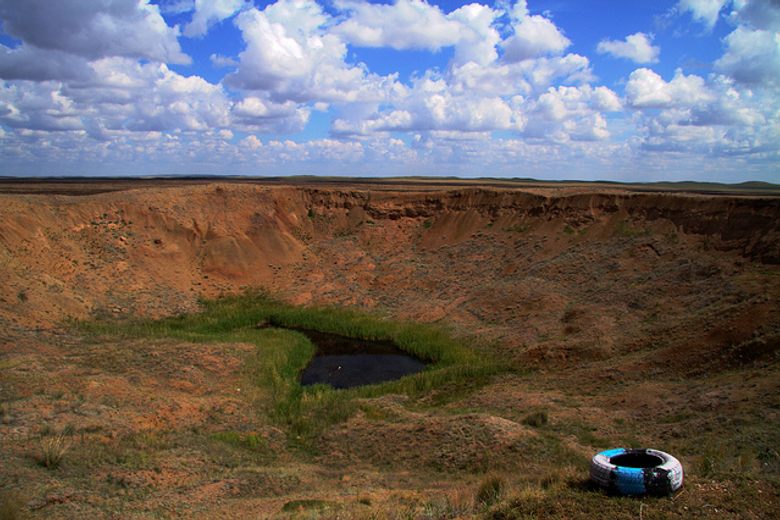Introduction
In 2018, a documentary series presented by David Ferrier – ‘The Dark Tourist’, showcased the city of Kurchatov, where they learn about the nearby Semipalatinsk Test Site, the primary testing site for the Soviet Union’s nuclear weaponry.
This remote and extremely dark location, southwest of the semi-abandoned village of Kurchatov, where the bomb itself was built, refined, and tested, is truly one of the most astonishing sites that an interested and involved allocentric traveller can possibly visit.

This Nuclear Polygon is where 456 such experiments with bombs of varying design, type, lethality, and explosion radius were conducted.
Here, tests on animals and equipment were conducted as well as atmospheric (i.e., above ground) and underground tests that have since been outlawed by international treaties. There are other rumors about tests that are far more nefarious.
The aftermath of this site would hold a lasting impression in the area. At a prenatal clinic in Semipalatinsk, 488 of every 1,000 newborns were delivered with birth abnormalities or other health issues, and 47 of those children died.
Location
Situated in the North-East of Kazakhstan, this brings an obstacle to overcome – How do you get there? Well, the sole legal route to the Semipalatinsk Nuclear Test Site is through Kurchatov.
Start and end points will be in Kurchatov, and it is recommended to spread out the visits mentioned above over two days—first to Opytnoe Pole, then to the Atomic Lake. Although the distances are great and the going is rough, anticipating a highway would be unrealistic given that this is the area where atomic weapons were employed. Get ready for a difficult journey as well as one of the most profound experiences of your life!
History
It all started back in 1949, Joseph Stalin would celebrate his 70th Birthday in this year. George Orwell would publish his dystopian novel – 1984, also the RDS-1, the first Soviet nuclear weapon, was a 22-kiloton bomb dropped from a tower here on August 29, 1949, and it was given the fascinating code name “First Lightning.”
The Test Site Museum in Kurchatov has models of this bomb on display. The USSR first tested a hydrogen bomb in 1955, the RDS-37, which had a higher level of lethality than a “regular” atom bomb.
A conversation between Lavrentiy Beria and Stalin led to believe how there was no life out in the provinces of Kazakhstan. Slave laborers from the Gulags got to work to start constructing the site. However, Beria was very wrong or maybe he just did not care. It has been estimated that 1.5 million people were exposed to radiation. Villages like ‘Znamenka’ were nomads roamed the plains while grazing livestock would live.
“Don’t worry about it, it is just an earthquake”
People who lived in the 200km radius of the activities were affected in the short term with radiation sickness and in the long term there would be a rise in cancer and the next generations to be born with deformities. However, tourism saw the blasts to be sold as an opportunity by selling hotel rooms facing the blast and ‘Atomic’ Cocktails. Maybe we can try out some of the Atomic ‘Cocktails’.
Tests began to take place underground in the early 1960s; mines and tunnels were excavated, then destroyed in a blaze of unfathomable energy. Both civilian and military applications of nuclear explosions were tested during these experiments, which were both military in character. One of these explosions made the well-known Atomic Lake. Known as the “Atomic Lake,” Lake Chagan or Lake Balapan is a lake in Kazakhstan that was formed because of the Chagan nuclear test and is approximately 10,000,000 m3 (8,100 acre-ft) in size.
Currently, all nuclear activity in this polygon is research-based, and local scientists have access to a test reactor on-site. Along with clean-up, decontamination, and efforts to protect any potentially dangerous radioactive sites from any would-be villains who might be interested in obtaining this awful stuff, research is also happening into the legacy of the weapons that were used here in the past.
Because of all of this, access to the Polygon is restricted and authorization is required. However, because it is a large region in a somewhat underdeveloped area of the country and anybody may enter from almost anywhere with a 4×4, there has been a lot of theft over the years (as many places as possible).
It takes a lot of dates, figures, science, and imagination to visit this location. But the tour guides will paint the scenario so vividly thanks to their excellent storytelling abilities. Of course, the best way to experience it is to go and see it for yourself.





